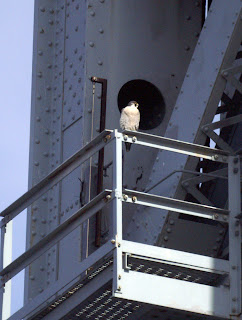Sunday Feb 26, 2012
Eric Miller asked me if I was going to try for the Virginia’s Warbler that has been residing in Maryland. It turns out that I had been asked the same question by Jean Loscalzo earlier in the week, and it would seem that the prospect was gaining steam, with my chasing juices started to flow.
I had a life Virginia’s Warbler many years ago in California. I had made a trip out to the Big Morongo Canyon Preserve in 1989 because I longed for seeing warblers, and I heard that this was a good place for seeing them. While there, I saw a few familiar and a few new warblers, and crossed paths with Dick Dunlap for the second time. He and I crossed paths coincidentally once before chasing rarities from the LA-RBA.
He asked me what I had seen, I rattled off a small list, and pointed in the direction of a Nashville Warbler I had just seen. In typical Dick format, he said: “No it’s not, that’s a Virginia’s Warbler” I took another look, and waited for the bird to come into view completely. Either I was mistaken in my initial ID or this was another bird, but this was my life Virginia’s.
Ten years later I did a trip to Colorado and Utah with Ian Resnick, and Virginia’s Warbler was one of our target species. I had several potential places on the itinerary, but this is one of the few species that we dipped on. So when I called Ian and asked if he wanted to go, he didn’t hesitate.
So three out of four of us had the potential for a lifer, the weather forecast was great, and we were chock full of enthusiasm. We left dark and early at 5am to try to beat the traffic that lumbers down the highway in a manner consistent with the occupants’ indecision about whether or not they are actually interested in getting to their destination. The other side of the coin with little traffic, is that there are less people on the road who can speed and be caught by the cops instead of you. We dodged a bullet or two, and made good time to our destination.
Along the way we were pleased to see four Bald Eagles amongst the more expected species. Although truth be told, with the heart warming success of this species, perhaps it should be considered an ‘expected species’ at this point. They are turning up all over the place. Yippee!
In the sky above us, there were also lots and lots of Snow Geese. Huge flocks were on the move, and this would continue throughout the day climaxing at sunset with thousands flying by in the fading light.
Arriving at the Pickering Creek Audubon Center in Easton MD, I inquired of our party if anyone had come across any info about where to look. All we knew was that it was being seen in the Groundsel. But in short order we found some other birders, and they had just seen the bird and told us where to look. Here is a map.
 |
| Eastern Bluebird |
Before long, Ian and Eric heard the bird calling, and they got the first looks. The bird moved around a bit but we were mostly able to tell where it was by its call notes. When the warbler wasn’t calling, I checked the sky for raptors and found Black Vultures in amongst the Turkey Vultures, as well as more bald Eagles, and a pair of Red-shouldered Hawks that were calling. Nice. Eric took a walk down another path and he heard a Barred Owl call.
 |
| Red-shouldered Hawk |
 |
| Black Vulture |
 |
| Field Sparrow |
 |
| Virginia's Warbler. No really, its in there! |
 |
| Horned Grebe |
Arriving at the same time as we did was a couple from New Jersey. He an avid birder bent on getting the Western Grebe, she a partially willing significant other apparently dragged along for the ride. Disappointment at the no-show of the Grebe turned to elation at news of the warbler we had just seen. Jean helped them with as much directional information as possible, but it would seem that the roughly 75 miles west to the warbler may have been too much. I hope they went, got it, and she was treated to a nice dinner in recompense for putting up with her birding partner.
We decided to go down the road to Cape Henelopen and try from some other vantage points, but it became clear the bird was not there. We then went to the nature center where the Brown-headed Nuthatches and Carolina Chickadees do not disappoint! If you need these birds, especially the nuthatch, this is the place to go!
We then set off for Bombay Hook NWR. There were a number of targets that we wanted to see there and time is off the essence. At our first stop we got the Black-necked Stilt as well as some Greater Yellowlegs in Raymond pond, and heard Screech Owl calling! Eric also heard a Great Horned Owl call, but it was too distant for the rest of us to hear.
 |
| Brown-headed Nuthatch |
 |
| Carolina Chickadee |
Continuing on the tour we saw nice numbers of Green-winged Teal and Pintail. Also seen were at least 60 Tundra Swans. With light fading, we made our way out of the refuge. But before we could exit, we heard Woodcocks peenting, and I saw a flew display. A nice cap to the day. We then beast a hasty retreat for the long ride home, which thankfully was mostly devoid of traffic.




















